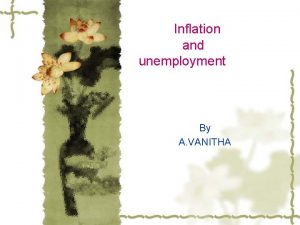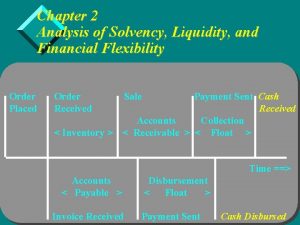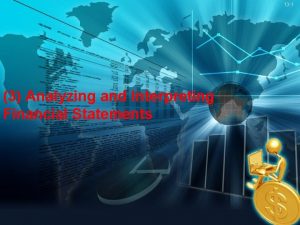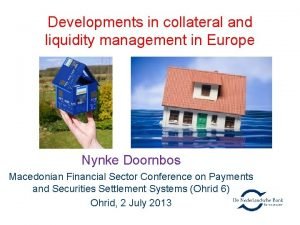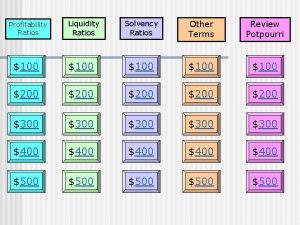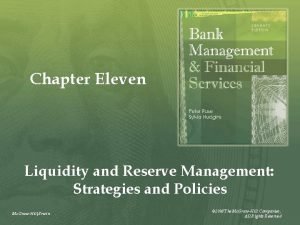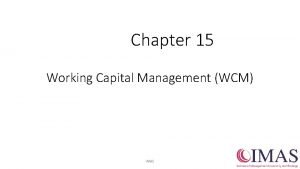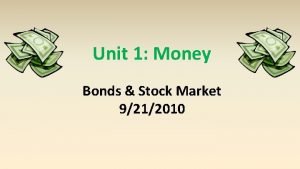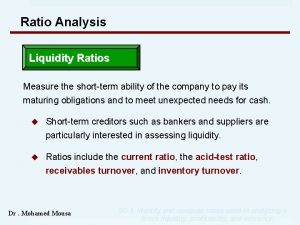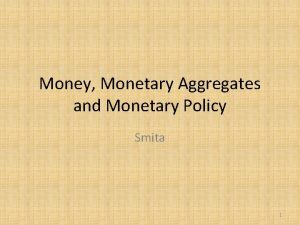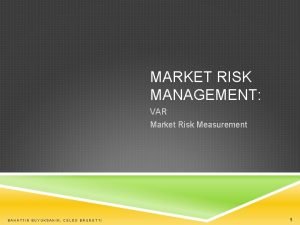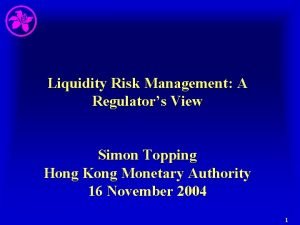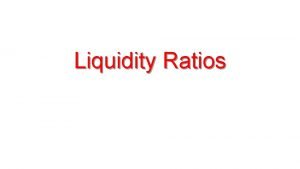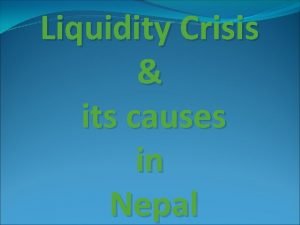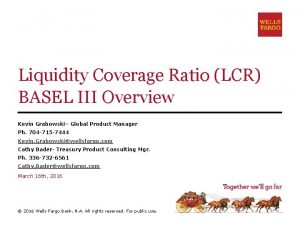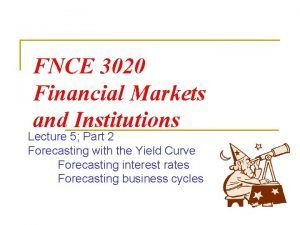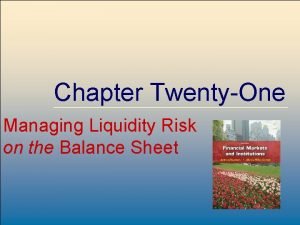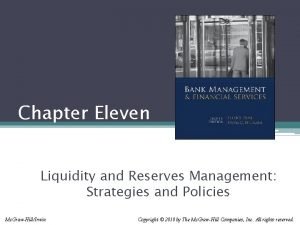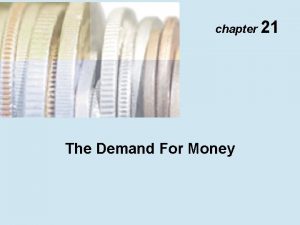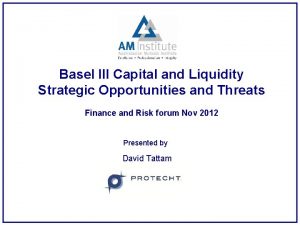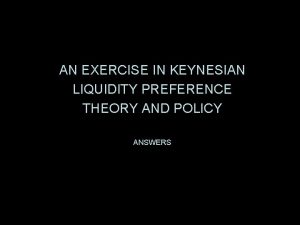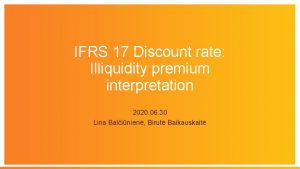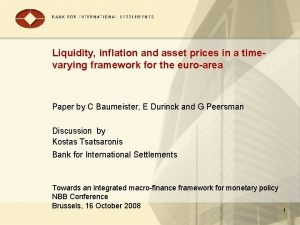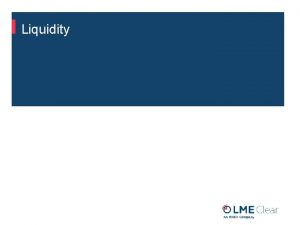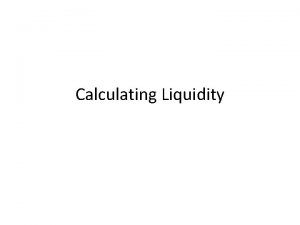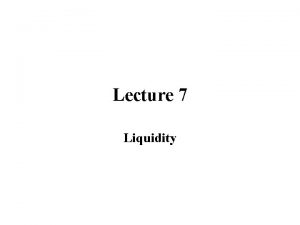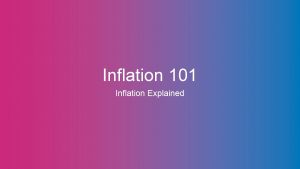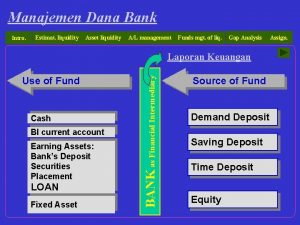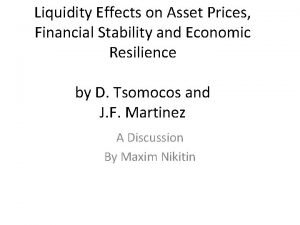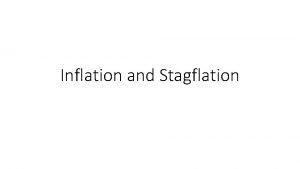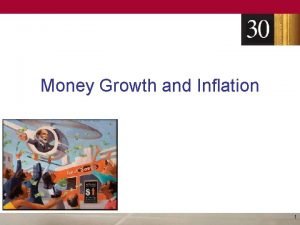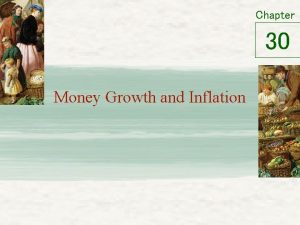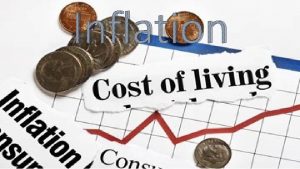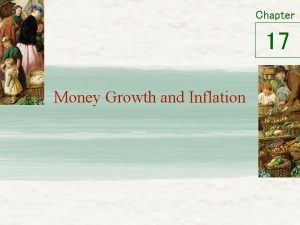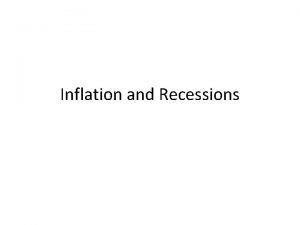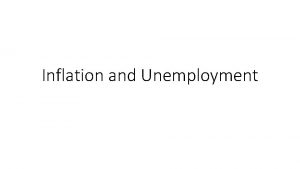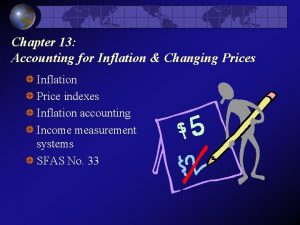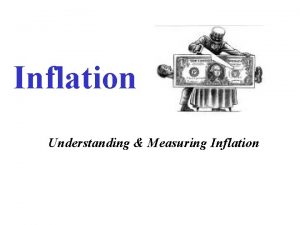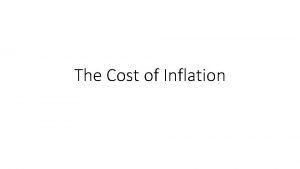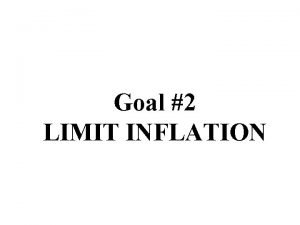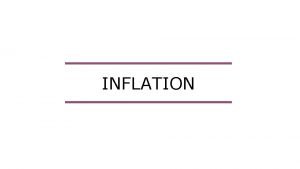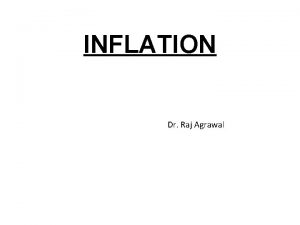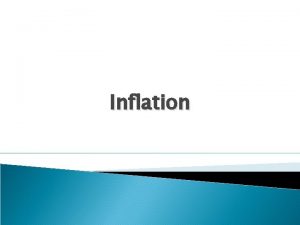Liquidity Inflation and Asset Prices in a TimeVarying























- Slides: 23

Liquidity, Inflation and Asset Prices in a Time-Varying Framework for the Euro Area Christiane Baumeister Eveline Durinck Gert Peersman Ghent University

Motivation • One “pillar” of ECB policy strategy: money aggregates as an indicator of risks to price stability – Has been subject to intense criticism • Gerlach (2004) and Hofmann (2006): distortions of relationship between money growth and inflation over time – ECB: “no mechanical reaction but a comprehensive assessment of the liquidity situation based on information about the balance sheet context as well as the composition of M 3 growth” • Gerlach (2007) and Fischer, Lenza, Pill and Reichlin (2008): there is a reaction, but also depends on information from the economic analysis – Link between excess liquidity and future inflation is probably not constant over time and depends on other factors as well

Motivation • Monetary analysis could provide early information on emerging financial imbalances (asset price bubbles) – Christiano, Motto and Rostagno (2006): theoretical support for correlation between strong credit growth and boom-bust episodes in asset prices – Detken and Smets (2004): high-cost booms in asset prices often follow rapid growth in money and credit stocks – Also episodes in history where excess money growth is not followed by financial imbalances – Growing literature which shows that the impact depends on the underlying state of the economy • Asset price boom-busts, financial liberalization, business cycle, … – Information of liquidity for asset prices is probably also not constant over time and state dependent

This paper • Investigates the link between money, economic activity, asset prices and inflation in a time-varying and state dependent framework for the Euro area – SVAR to estimate the impact of liquidity shock • Benchmark • Distinction between the source of increased liquidity (M 1, M 3 -M 1 and credit) – Time-varying effects of liquidity shocks on the economy • A simple sample split (mid-eighties) • BVAR with time-varying parameters and stochastic volatility – Liquidity shocks and the state of the economy • Does the impact depend on the state of the economy (asset price boom-busts, business cycle, credit cycle, monetary policy, …)?

Impact of liquidity shocks • Benchmark SVAR for the period 1971 Q 1 -2005 Q 4 – Real GDP growth, HICP inflation, interest rate, real asset prices growth and money growth (M 3) • Aggregate asset prices, property prices and equity prices – Recursive identification: exogenous shocks to liquidity which are not related to endogenous developments due to business or asset price cycles (“excess liquidity” like money overhang)

Impact of liquidity shocks • 1% long-run rise in M 3 – Temporary positive effect on real GDP – Impact on prices is less than proportional: there is a permanent rise of real money holdings

Impact of liquidity shocks • 1% long-run rise in M 3 – Significant positive impact on real asset, property and equity prices

Impact of liquidity shocks • Distinction between shocks to M 1, M 3 -M 1 and credit – Rise in M 1 has a proportional impact on prices and a considerable effect on output (spending indicator) – M 3 -M 1 has a much lower effect on output and prices: there is a permanent rise in real money holdings (change in portfolio preferences)

Impact of liquidity shocks • Distinction between shocks to M 1, M 3 -M 1 and credit – Impact of shock in counterpart credit is similar as M 3, except a stronger effect on output – No noticeable differences for impact on real asset prices

Time varying effects of liquidity shocks • A simple sample split – Pre and post 1985 • Bayesian VAR with time-varying parameters and stochastic volatility – In the spirit of Cogley and Sargent (2002, 2005), Primiceri (2005), Benati and Mumtaz (2007) – Allows for smooth transitions over time and captures possible nonlinearities – Volatility of liquidity shocks is allowed to change over time (heteroscedasticity of the shocks) – Note: 1971 -1978 is used as a training sample to calibrate the priors

Time varying effects of liquidity shocks • Impact on output is significantly smaller for post 1985 period, but rises again during certain periods

Time varying effects of liquidity shocks • (near) proportional impact on prices before early 1980 s while more permanent effect on real money holdings afterwards • But: impact on inflation is also varying over time with noticeable increased impact in more recent period

Time varying effects of liquidity shocks • Time-variation for asset prices not very clear

Liquidity and the state of the economy • Growing literature arguing that the impact depends on the underlying state of the economy which can also affect the time-varying results – We consider 5 regimes simultaneously • Single equation approach for output growth, inflation, nominal and real asset price growth

Liquidity and the state of the economy • Asset price booms and busts – Bank behavior changes in asset price booms • Herring and Wachter (2003) and Adrian and Shin (2008) • Rising bank capital and stronger balance sheets of banks: more willing to hold loans and possibilities for additional lending • Value of collateral on outstanding loans rises, reducing the risk on existing portfolio: more additional lending possible • Behavioral characteristics of banking sector (e. g. moral hazard) – Self-reinforcing process via the financial accelerator (asset prices as collateral), wealth effects, Tobin’s q channel – Empirically confirmed by Adalid and Detken (2007) and Goodhart and Hofmann (2007) in cross section dimension – Asset price boom regime: when real aggregate asset price index exceeds its trend by more than 10% for at least three quarters

Liquidity and the state of the economy • Asset price booms and busts: results – Stronger impact on output, inflation and real asset prices • Not significant for property prices – Also stronger effect on output and real asset prices in a bust • Including property prices – Economically very relevant!

Liquidity and the state of the economy • Business cycle – Financial accelerator weaker in booms: less external financing, high collateral and cash-flow values • Bernanke and Gertler (1989) • Weaker effect on economic activity and prices – Convex short-run aggregate supply curve • Weaker effect on economic activity + stronger effect on prices – Peersman and Smets (2002): output effects of monetary policy stronger in recessions – Economic boom: when real GDP growth is above its trend for at least three quarters

Liquidity and the state of the economy • Business cycle – Weaker impact on output in economic booms • Consistent with financial accelerator (-) and convex supply (-) – No asymmetry for inflation and equity prices • Financial accelerator (-) and convex supply (+) cancelling each other out? – Stronger impact on property prices • Dominance of convex supply curve (+) in property market? – Economically also very important

Liquidity and the state of the economy • Financial deregulation and liberalization – Safest segment of borrowers shifts away from the banking sector towards the capital and stock markets • Strengthens the financial accelerator channel: search for new customers leads banks to smaller and riskier borrowers which increases the importance of collateral – Confirmed by evidence of Borio, Kennedy and Prowse (1994), Goodhart, Hofmann and Segoviano (2004) and Calza, Monacelli and Stracca (2006) – Credit boom: minimum three quarters in which money/credit to GDP ratio grows faster than its trend

Liquidity and the state of the economy • Financial deregulation and liberalization – Stronger effect on output and all types of asset prices • Inflation depends on the specification – Economically very important

Liquidity and the state of the economy • Inflation regimes – Borio and Lowe (2002) and Borio (2006): improved central bank credibility and increased globalization could reduce the impact of liquidity shocks on inflation, which could instead be translated into higher asset prices – Goodhart and Hofmann (2007): increased responsiveness of asset prices over time • Gerlach (2004) and our results: reduced impact on inflation over time – Inflation boom: inflation is at least three quarters higher than its trend value – Results • No robust asymmetry

Liquidity and the state of the economy • Monetary policy stance & positive versus negative liquidity shocks – Restrictive monetary policy stance implies weak balance sheets of firms and a stronger financial accelerator • Balke (2000), Atanasova (2003) and Calza and Sousa (2005): stronger output and inflation effects at times of tight policy – Similar reasoning to expect stronger effects of negative liquidity shocks relative to positive liquidity shocks (because liquidity constraints more binding) • Convex short-run aggregate supply curve also predicts stronger output effects but a weaker impact on prices • Cover (1992): stronger effects of negative money supply shocks • Oliner and Rudebush (1995): financial accelerator is stronger after restrictive monetary policy shocks – Restrictive monetary policy: when actual interest rate is higher than interest rate obtained from Taylor rule

Liquidity and the state of the economy • Monetary policy stance & positive versus negative liquidity shocks – Restrictive monetary policy stance • Somewhat stronger effect on output and asset prices but not robust • Weaker impact on inflation but economically relative small – Negative versus positive liquidity shocks • Negative shocks have significant stronger effects on output and all types of asset prices • Weaker effect on inflation • Economically relevant asymmetry
 Futa inflation meaning
Futa inflation meaning Define liquidity financial flexibility and solvency
Define liquidity financial flexibility and solvency Plastic limit formula
Plastic limit formula Liquidity profitability and solvency
Liquidity profitability and solvency Liquidity planning and managing cash assets
Liquidity planning and managing cash assets Xborder funding mc
Xborder funding mc Liquidity profitability and solvency ratios
Liquidity profitability and solvency ratios Liquidity and reserve management
Liquidity and reserve management Maturity matching working capital financing policy
Maturity matching working capital financing policy Liquidity premium theory
Liquidity premium theory Liquidity ratio
Liquidity ratio Liquidity adjustment facility
Liquidity adjustment facility Liquidity risk definition
Liquidity risk definition Liquidity concept
Liquidity concept Liqudity ratio
Liqudity ratio Causes of liquidity crisis in nepal
Causes of liquidity crisis in nepal Liquidity coverage ratio
Liquidity coverage ratio Liquidity premium theory
Liquidity premium theory Stored liquidity management
Stored liquidity management Balanced liquidity management strategy
Balanced liquidity management strategy Liquidity preference theory
Liquidity preference theory Basel ii
Basel ii Liquidity preference theory
Liquidity preference theory Liquidity premium damodaran
Liquidity premium damodaran
